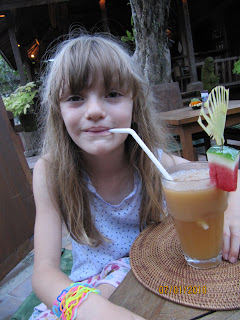






On our first day in Bali, we were leery about attending a Hindu cremation. It wasn't just the morbid reality, but it was this sense of our crashing someone's intimate family funeral. A time for personal grieving.
Intimate it was not. And no one cried. It was so un-intimate that the moment we stepped out of the car, women swarmed around us, aggressively wrapping sarongs around us, insisting that they were necessary to attend a cremation. It would be sacrilegious without them, they argued, trying to make us buy $3 sarongs for $20 each. We righteously refused being taken advantage of, then had second thoughts as the throngs heading towards the ceremony were covered in sarongs, even foreigners like us wearing freshly-bought $20 sarongs.
We were soon lost in the crowd, invisible foreigners, lining the crowded ceremonial procession route. No one was thinking of sarongs, we soon realized, they were just focused on standing in the shade and surviving the blistering heat. And, standing, and standing, for what felt like hours. At one point, I felt dizzy and just sat on the ground. We didn't have any food other than nuts, which we devoured having had no lunch, as we watched woman after woman carrying delicious food covered in flowers. We then ran out of water.
All the while, we watched as they scrambled to coordinate hundreds of people to make the cremation procession happen. Why was the cremation so huge? It was for the "queen," we were told by all the locals. The queen was a ceremonial leader of the local region, having been a real ruler before Indonesia nationalized all its 17,000 islands, combining them into one territory. She was Brahmin so everything was in white. Lower caste cremations are in red or black.
After the long wait, the gamelan players got in place and started playing. It was transporting, focusing music. Everyone seemed to know the tune. Then the procession finally started moving. Everything was carried by hundreds of men using strong bamboo poles to carry everything -- gamelan instruments, drums, beautiful young ladies holding up flowers and food, Hindu god statues to ward off evil spirits, and, at last, the coffin, walked up many white steps to the top of a decorated tower with a priest and coffin pallbearers, at least of them carrying a complicated set of bamboo poles to somehow, impossibly move the huge tower and coffin along the long procession.
We were enthralled. And thirsty. And hungry. Once the procession passed, continuing onto the cemetary for the burning of the tower and coffin, they planned to set the burning coffin on a float and push it out to sea. All a lyrical, spiritual burning to watch, filled with meaning.
But, we passed on it. Moving on to fill our bellies. Back to town for freshly squeezed juices. Feeling very much alive.




 Agung, our tour guide extraordinaire, took us to a little town outside of Ubud, the arts and crafts capital of Bali. In this woodcarving town, he found a hidden courtyard with woodcarvers wielding animal carvings. Agung took us to this place since he knew the woodcarvers would be willing to teach the kids how to carve.
Agung, our tour guide extraordinaire, took us to a little town outside of Ubud, the arts and crafts capital of Bali. In this woodcarving town, he found a hidden courtyard with woodcarvers wielding animal carvings. Agung took us to this place since he knew the woodcarvers would be willing to teach the kids how to carve.









